Dear Visitor,
I welcome you to this non-profit, educational page. Here you will read about different aspects of the history and culture of that part of our globe which is known variously as Bharatvarsha, Hindostan or India. My approach of looking at history is that of a rationalist and humanist. As my aim is to spread awareness about history and culture, you may freely download this page, print it, link it up from your site, or mirror it at any server. Enjoy the infotainment laid out for you at this site. I also look forward to your valuable suggestions and feedback. Happy viewing.
Author |
|
Hindu History
- Religious Tolerance and Secularism in India
___________________________________________________
________________________________________________________
Table of Contents
_________________________________________________
Many a times the question that arises in the mind of an Indian is - why are we secular? This question becomes more demanding for an answer when we feel the heat of communal conflagrations. India being still a traditional society that contains not one, but many traditions owing their origin in part to the different religions that exist here. While India carries with it many traditions it has managed to retain the secular character of its polity, while in many countries especially from the third world, a secular authority has crumbled in face of conflicting traditions. Lebanon and Cyprus are only two instances. Even in those countries where a single tradition holds sway, secular forces have not always been able to hold their own against the forces of tradition. Iran and Algeria being a case in point.
 | A Vaishnava Hindu Temple from the Khajuraho Temple Complex in Madhya Pradesh The nature of the Hindu religion is conducive to religious tolerance. This religion is unique in the sense that it is the only surviving major
religion today that has retained a continuous link with its hazy origins in
antiquity. Hinduism has no founder, no code of beliefs, it never had any religious
organisation that wielded temporal power over its followers. |
Secularism actually means an attitude unconnected with any
religion. But if asked its meaning an Indian would invariably say that
secularism means 'religious tolerance'.
Why is it that this term which is
enshrined in our constitution should have a popular misconception about
its meaning? To answer this question we would have to probe deeper into
Indian polity and the dialectics of Hinduism, the religion of the
majority.
The Roots of religious Tolerance in India - the Pluralism of Hinduism
The Hindu religion is unique in the sense that it is the only surviving major
religion today that has retained a continuous link with its hazy origins in
antiquity. Hinduism has no founder, no code of beliefs, it never had any religious
organisation that wielded temporal power over its followers.
Its
distinguishing characteristics are its diversity and multiplicity. The term
Sanatana dharma, which is also used to refer to this religion reflects its
character - Sanatana means continuing. The religions of the Mesopotemians,
ancient Greeks and Romans were similar to Hinduism. But they were replaced by
Islam and Christianity, both of which are monotheistic religions.
Rigid Social Structure of Hinduism
But, ironically, though Hindu philosophy is very liberal and tolerant, the social framework that is associated with the Hindu
religion, displays rigidity in its extreme. For instance, the
hereditary caste system, or the ban on re-conversion into Hinduism of those who had got themselves converted or were forcibly converted to other religions.
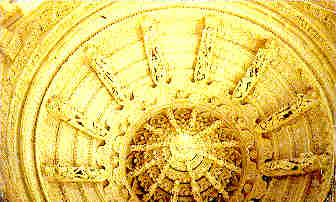 | Hinduism is not one religion. This 'Collection of DifferentModes of Worship' is in its nature, a collection of different streams of human thinking from an undated past. Hinduism has no founder, no code of beliefs, it never had any religious
organisation that wielded temporal power over its followers. (Seen here is the roof of a Hindu temple from inside.)
|
Worship of the forces of Nature
But
taking a closer look at the methods of worship, Hinduism
displays a tendency to change phenomenally over time.
Students of Vedas know that in Vedic times nature worship
was prevalent. The five forces of nature - the Pancha
Mahabhoota included Teja (light) represented by Agni
(fire), and Surya (sun), the other four were Vayu (wind),
Aapa (water), Akasha (sky), and Prithvi (earth). These
forces of nature were the first to be worshipped, The personified Gods like Vishnu with his ten incarnations, came much later.
The Personified Incarnations (Avatar)
The Vishnu incarnation idea
is suggestive of the theory of evolution and Man's social
progress. Beginning with Matsya, the fish; followed by the
amphibious tortoise, Kurma the mammalian boar Varaha; followed by the
half beast half man Narasimha, to the dwarf Vamana, the axe
wielder Parasurama and the warrior king Rama, the cultivator Balarama and the cowherd
Krishna to the enlightened Buddha. The last incarnation Kalki is yet
to appear.
Its distinguishing characteristics are its diversity and multiplicity. The term
Sanatana dharma, which is also used to refer to this religion reflects its
character - Sanatana means continuing.
Hinduism is an umbrella term for a collection of different theistic (and agnostic) attitudes. The Hindu religion is unique in the sense that it is the only surviving major
religion today that has retained a continuous link with its hazy origins in
antiquity. Hence it incorporates virtually all shades of human opinion. The above incarnations are only a few from the Hindu
pantheon, there are many others like Brahma, Shiva, Ganapati,
Shakti, Kartikeya, Sheshnaga, etc. The point that comes from
This, is the endless multiplicity of objects of worship that has
existed in this religion. The Hindu pantheon has been an ever
growing one and has grown in an overlapping manner, with
constant additions being effected at various times and places.
Because of this, a follower of this religion may not
even be aware that a said deity forms part of the Hindu
pantheon and may not recognise it as such, even if he comes to know.
Due to this a Hindu's religious consciousness has been a
vague one and his commitment to his religion has not been as
fanatical as in the cases of monotheistic religions.
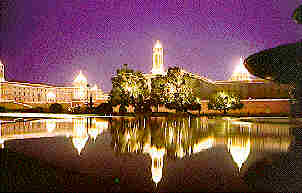 | Symbol of an enduring tradition of Religious Tolerance. Seen here is the Secretariat of the Sovereign, Secular, Socialist, Democratic Republic of India at New Delhi. This building consists of four administrative blocks known popularly as the South Block, the North Block, the East Block and the West Block. |
The Mushrooming of Various Hindu Sects
The mushrooming of innumerable local sects Hinduism has
been an inevitable result. This endless and overlapping
multiplicity of sects originating from a common system of beliefs,
made essential, the tolerance of every sect and sub-sect of
each other. At times, the sects disassociated themselves from the main body and went their separate ways as in the case of Buddhism, Jainism, and Sikhism. But the pluralistic tendency they had inherited from their mother faith re-asserted itself and the process of split and re-split in these offspring religious sects continued. The Buddhists are split into Mahayana and Hinayana sects, apart from Zen, Lamaism, etc. The Jains are split into Shwetambar and Digambar sects. The Sikhs are a small community which are split into innumerable sects like the Akalis, Nirankari, Radhasoamis, Udasis, Nihangs, Nirmalas, Sanyasis, Namdharis, etc.
Adi Shankara's Attempts to Organise Hinduism
This character of Hinduism prevented the formation
of a central body on which could devolve the authority of taking decisions about Hindu religious
affairs. Adi Shankaracharya did make an attempt to integrate Hinduism. His attempts led
to the foundation of monasteries (Mutts) in charge of bishops (Jagadgurus) like the ones at
Kanchi, Dwarka, Badrinath and Puri. But even this system
failed to wield Hinduism into a monolithic religion. This System did not even receive the
following of Hindus all over and in the absence of any temporal power to back it up, coupled
with the presence of rival centres of spiritual power in the various localized
deities and godmen, the Jagadgurus came nowhere near the Pope or the Caliph. This feature
which demonstrates the lack of capacity for organisation of the Hindu
religion deprived it, since historical times till today, from having any
effective institutional means by which it could confront the state
and make demands upon it.
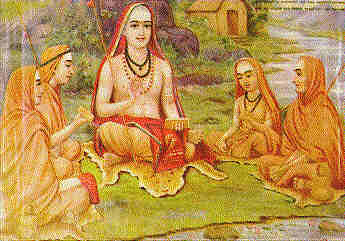 | Adi Shankaracharya with his disciples. |
No Congregational Worship in Hinduism
There is even no congregational worship in Hinduism such as found in
Christianity and Islam. "In Christianity the parish church is a
center of organised religious activity and the basic unit of
ecclesiastical organisation. The lack of a clearly defined and trained
Hindu clergy subject to the discipline of superiors is another
point. The hereditary priesthood of the Brahmin caste has hot
functioned effectively, and relatively few Brahmins
these days are priests by actual occupation. The
functions of the clergy in Hinduism are performed by a wide variety f temple
priests, pandits, astrologers, Sadhus (holy men), Swamis, Gurus and
so forth.
"The Hindu "clergy" is thus not organised for an
effective political role, nor do the Sadhus and temple priests enjoy the
general prestige which would make for success in politics."
(Donald Eugene Smith, ' India as a Secular State' , Princeton
University Press:. Princeton, New York. U S.A.. 1963 P 28)
.
Commenting on the lack of ecclesiastical organisation among
the Hindus, a British scholar has written. "Hence Hinduism has
never prepared a body of canonical Scriptures or a Common Prayer
Book; it - has never held a General Council or Convention; never defined
the relations of the laity with the clergy; never regulated the
canonization of saints or their worship; never established a single
center of Religious life, like Rome or Canterbury; never prescribed a course of training for its priesthood."
This absence of a central co-ordinating authority within the Hindu religion
also left no check on the mushrooming of mutually exclusive forms
of worship. For instance both Rama and Ravana (portrayed as enemies in
mythology) are reversed, though the latter has only a small following in parts
of South India. In Hinduism no spiritual body could issue
religious edicts. There is no parallel of a Papal Bull or a Fatwa or
Hukumnama in Hinduism.
Hinduism is not One Religion - it is a Collation of Human Thinking on Attitudes Towards Worship
The multiplicity of Hinduism, also reflected itself in
the absence of any terms to identify Hinduism. The term
'Hindu' itself is a result of corruption of the word 'Sindhu' by
the Persians who could not pronounce the word Sindhu as the
letter 'S' was missing in Pahelavi, the language of the
ancient Persians.
The reasons; viz. the tribal origin in antiquity, the
multiplicity of cults, sects and deities, the absence of a
central authority, etc, made Hinduism an assimilative
religion which tolerated different sects that mushroomed
from itself and even absorbed minor sects whose origins lay
outside Hinduism (e.g. worship of the various mendicants like Saibaba at Shirdi in Maharashtra) and when it came in contact with religions from
other countries it did not resist their assimilation into
itself.
 | According to an American Indologist, "The Hindu "clergy" is not organised for an
effective political role, nor do the Sadhus and temple priests enjoy the
general prestige which would make for success in politics." -
Donald Eugene Smith, An American Indologist |
(W. Crooke, 'Hinduism, - Encyclopedia of Religion and
Ethics,' ed.
James Hastings, 1925, Vol 6p. 712.)
Even when Hinduism came into contact with aboriginal peoples like the Adivasis) no attempt was
made to formally convert them to Hinduism. They were gradually Hinduized and absorbed into Hinduism. This was
sometimes done by incorporating tribal deities into the Hindi and they became a Hindu cult. Hinduism thus spread by
assimilation and acculturation. Thus Hinduism cannot be called one religion, it is more a collation of human thinking on attitudes towards worship,
The Vedic seer had proclaimed "Truth is one; people call it by various names" (Ekam Satya, Viprah Bahudaa Vadanti).
The Chosen Deity - Ishta Devata
The Hindu
doctrine of having an ishta-devata (chosen deity) invites every Hindu to select his deity from the wide pantheon
of various gods and goddesses conceived since time immemorial. While this liberal doctrine was originally
applied to the numerous deities mentioned in the Hindu scriptures, there is no logical stopping point, and hence the
same tolerant attitude is taken towards other religions who have defined frontiers.
"Hinduism thus holds that there are many ways, many paths which lead towards salvation or spiritual
liberation. Historically it has convincingly demonstrated this belief. The following info will bear this out.
In addition to Sikhs, Jains and Buddhists, who have emerged as reform movement from Hinduism, we have had
communities of Jews, Syrian Christians, and Zoroastrians who settled in India and lived there unmolested. Muslims lived
peacefully in India for three hundred years before Islam came as a military force in the eleventh century C.E.
Hinduism, unlike Buddhism, Christianity and Islam, is not a missionary religion, and the rejection of
proselytism on principle is regarded by many Hindus as an important part
of tolerance". Thus "tolerance is a strong point
in support of the secular state ".
(W. Crooke, 'Hinduism, - Encyclopedia of Religion and
Ethics,' ed.
James Hastings, 1925, Vol 6p. 712.)
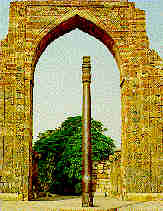 | The endless and overlapping multiplicity of Hindu sects made essential, the tolerance of every sect and sub-sect of each other. This attitude of tolerance was extended to all forms of belief that came into India from other parts of the globe including Islam and Christianity. These monotheistic religions required a specific conformance from their followers in their mode of worship and cultural identity. On the contrary, the central principle that emerged from the chaos of Hinduism was that the way to salvation was a matter of personal and individual choice.
(Seen here is the iron pillar at Delhi which was cast by ancient Hindu metallurgists about 2000 years back but, like the Hindu spirit of tolerance of diversity, has remained rust-proof in spite of the attacks of rain and sun on it for over 2 millennia. Symbolically in this photograph, the incorrigible iron pillar, like the spirit of tolerance of diversity of the Hindus who cast it, has survived, but the arch put around it later by the Muslim invaders is seen crumbling today.) |
Relationship Between The State and Religion in Ancient India
As in the West, the idea of separation of the Church from the state has also existed in India since
ancient times. Hindu traditions lend strong support to the idea that the functions of the priest and king are to
be separated. According to the 'divinely ordained' caste system, the priestly function belonged to the Brahmins
while the rulership vested with the Kshatriyas. The Brahmin
priest was expected to advise the king, but could not himself rule as per the caste rules.
In ancient India it was the king's duty to promote dharma. Now the
term dharma has a wide connotation involving law, duty, morality and religion.
Thus dharma did not just connote administration it also had ecclesiastical overtones. The king was
expected to encourage piety and virtue and also aid religious
institutions.
Government was not based on a theocracy and considerable impartiality was
practiced in the treatment accorded to various sects - irrespective of the sect to which a king belonged. However, the
religious overtones of regal policy were very pronounced. The ancient Hindu State, like today's Indian
State, was tolerant towards all religions, was equidistant from all religions and also generally gave equal promotion to all
religions. But despite all this it could not be called secular as it was not a
non-religious state and the promotion of dharma tied it down to ecclesiastical pursuits
which cannot go into the making of a secular state as per the Dictionary meaning of the term.
In promoting dharma the state in ancient India built temples, granted
them large endowments, and exercised
strict supervision over their affairs. As the Hindu
kings were tolerant towards all creeds and frequently aided them all, the
foundations of religious tolerance which is one of the bases of
secularism could be said to be indigenous to India. In addition a clear-cut
distinction was made in ancient Indian polity between the functions of the priest and the king.
There was an intimate relationship between the Brahmin clergy and the Kshatriya nobility. The Brahmin, Purohita (royal
chaplain) occupied a prominent position at the court of a Hindu king. The purohita also wielded considerable influence over the king through his rule as the King's Guru
(spiritual preceptor) .
In the Gautama Dharmasutra (circa 500 B.C.)
It is stated that even the King's authority could not touch the Brahmins, since they are
representatives of God on earth, and the king's prosperity depended on divine blessings which only the
Brahmins can invoke. In other texts the king is warned that if he fails to employ a qualified Brahmin
priest, his oblations would not be acceptable to the Gods. Even the success of a king was said to
depend on his bowing three times before the Brahman Purohita at his coronation, and thus accepting
a subordinate position. The king traditionally was portrayed as a protector of cows and Brahmins.
Bitter
curses are pronounced in the Dharmashastras, against rulers who confiscate the cows of Brahmins.
"But the Brahminical order never developed the kind of tight-knit organisation which would enable it
to enjoy an effective political role comparable to that of the church in medieval Europe. Furthermore, the
divinely ordained social system had clearly given the function of governance to the Kshatriyas.
(U.N. Ghosal
has referred to "The striking fact that this class (the Brahmins) throughout our history failed to assert (except
in theory and legend) its claim to control kings and emperors " This absence of an effective ecclesiastical
organisation within Hinduism even today is a significant factor in the development of a modern secular state in
India "
The general environment of religious liberty and
the official tradition of religious tolerance which prevailed in ancient India, represents one important
commonality with of the secular state in India today. The ancient Hindu state never sought to impose a particular creed
upon the people. In the words of Donald Smith various schools of thought propounded the doctrines of
agnosticism,
atheism and materialism. Jainism, Buddhism and later Judaism, Christianity, Zoroastrianism, and
Islam were permitted to propagate their teachings, build their places of worship, and establish their
respective ways of life. The struggle for freedom of conscience in Europe and America, stretching over
many centuries, has no counterpart in Indian History. From the earliest days this right seems never to
have been denied " (in India)
As the famed historian Max Weber put it: "It is an undoubted fact that in India, religions and philosophical
thinkers were able to enjoy perfect, nearly absolute freedom for a long period. The freedom of thought in
ancient India was so considerable as to find no parallel in the west before the most recent age."
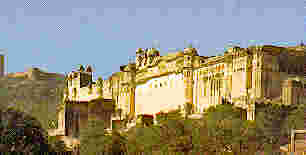 | According to an American scholar of Secularism in India, Mr. Donald Smith, "The Hindu state of ancient medieval, or modern times was not a
narrowly sectarian state in any sense; patronage was frequently extended simultaneously to various sects and
religions." But this inherent Hindu spirit of tolerance was not reciprocated by the Muslims who overran the Hindu kingdoms of India in the middle ages. Even the general architecture of Middle Ages reflects the siege situation that Hindu India had developed under the antagonistic Muslim aggressors. Most of the cities were then built not on the open plains as was the case earlier, but in hilly areas and were heavily fortified. (Seen here is the Amber Fort near Jaipur, Rajasthan.) |
Thus in India the secular state of today is built upon our substantial ancient historical
foundations. According to Donald Smith, "The Hindu state of ancient medieval, or modern times was not a
narrowly sectarian state in any sense; patronage was frequently extended simultaneously to various sects and
religions. The British policy of religious neutrality was the direct antecedent of the secular Indian state of today, and the legal and administrative institutions introduced by the British rulers pointed the way to
the development of a common citizenship. India's present system of secular public schools have Over a century of
history. The mainstream of Indian nationalism, which led to independence in 1947, had a decidedly secular
orientation throughout most of its history.
(Donald Eugene Smith, Op. cit. p. 61.,
Max Weber, The Religion of India: The Sociology of
Hinduism and Buddhism, Free Press Publishers, Glencoe,
Illinois, U.S.A., l956, Donald Eugene Smith, Op. cit. P. 493 .
Hinduism and Secularism
Hinduism the religion of the majority in India is a faith which on the whole is
favourable to the development of the secular state in India. The Hindu
view of history is that ultimately it is pre-ordained, thus a Hindu is
generally fatalistlc. Secondly, the material reality is also looked
upon as sn illusion. Jagat Mithyaa Brahmam Satya which roughly means ("The
world is an Illusion, The Ultimate Truth lies beyond it")sums up the
orthodox Hindu attitude towards the real world. This
kind of a fatalistic attitude towards history and the material
reality made the appearance of an aggressive theocratic tendency
very difficult.
Hinduism also has a strong tradition of freedom of conscience and
tolerance of religious diversity. Religious liberty for the Hindu is
not based on political expediency but on the conviction of the ultimate
oneness of the religious quest, howsoever varied the numerous paths which might be followed towards salvation.
Further, Hinduism also lacks ecclesiastical organisation and centralised
authority which would be essential for any kind of theocratic challenge
to a secular or for that matter a hostile theocratic state supporting some other religion. This explains the absence of a unified challenge of the Hindu
community when it was tyrannized for nearly 750 years by the various Mohammedan dynasties whose
administration was run on theocratic Islamic lines except in the reigns of
Akbar and to an extent Jehangir.
 | Another example of fort architecture from mediaeval India. This form of defensive architecture was made necessary by the aggressive proselytizing policies of the Muslim rulers of India. The Udaipur fort was a bastion where the banner of Indian indpendence was defiantly help up by the lions of Mewad like Rana Sanga, Udai Singh and Maharana Pratap all through the dark days of Muslim rule in India. |
The existence of sizable and influential religions minorities
in another factor which indirectly lends support to the secular
tradition. According to Donald Smith, "The Muslims and the Sikhs
have little in their respective traditions which lends positive
support to the concept of secularism, yet they will strengthen Indian
- Secularism chiefly by guarding the rights of their respective
communities." "Both the Muslims and the Sikhs have strongly
theocratic elements in their traditions, and secularism does not have much
inherent appeal, apart from their minority status"
The shallowness in the understanding of the concept of secularism
is illustrated by the statement of a Kashmiri Muslim Leader
in an interview published in the Illustrated Weekly of India
a few years back, in which he had asked for a clear explanation about
secularism, and had said that if secularism was found to be superior
to his religion he would not flinch from getting himself
converted to secularism. The understanding of secularism as just another religion, to which the only concession given is of its being possibly a better religion to which a person could get formally converted reflects a qeneral backward attitude and the inability of a member of any theocratic religion to perceive secularism as an attitude above religion, and more importantly, beyond religion.
According to the Dictionary meaning of
secularism, a modern polity need have nothing to do with any form of
religion. Secularism which ultimately is the political expression of
rationalism can never be a faith, it is, and will always remain an "attitude" if it
has to remain rational. If rationalism ever does degenerate into any kind religion. It would not
remain rationalism any longer.
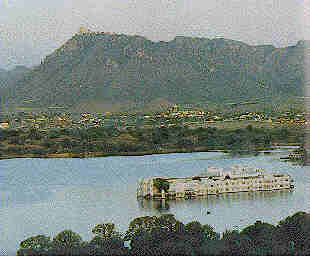 | The Lake Palace at Udaipur was built in the middle of a Lake for defensive purposes apart from aesthetic ones. The fort of Chittod, near Udaipur had been besiged and plundered by Allah-ud-din Khilji in his lust to acquire Queen Padmini. As Chittod was a center of Rajput resisitence to Muslim Rule, it was repeatedly attacked by the Muslims. Hence behind the construction of all Palaces built during mediaeval times, the underlying consideration was defense from enemy attacks. Even now, the Muslims would re-establish their theocratic rule, if they ever come to power again. This is evident from the kind of despotism that characterises Muslim nations, the world over. It is only when they are not in power would they support secularism and religious tolerance.
According to Donald Smith, "The Muslims
have little in their traditions which lends positive
support to the concept of secularism." "The Muslims have strongly
theocratic elements in their traditions, and secularism does not have much
inherent appeal, apart from their minority status" |
All religious minorities have a real interest in the maintenance of
the secular state. But among India's three largest minorities
only the Christians have a tradition of church-state separation
behind them. No doubt, it is the history of a religions community that
goes into the shaping of its attitude towards other
communities and towards a non-religious concept like
secularism.
_________________________________________
Now we move on to examine the Attitude of various Religious Communities in India Towards Secularism and see how they fare vis-a-vis Hinduism - the religion of the majority in India.
_____________________________________________________________
________________________________View the Table of Contents
_________________________________________________
____________________________________
_______________________________________
_________________________________
With your visit this page has been visited  times since 5th May 1998
times since 5th May 1998










